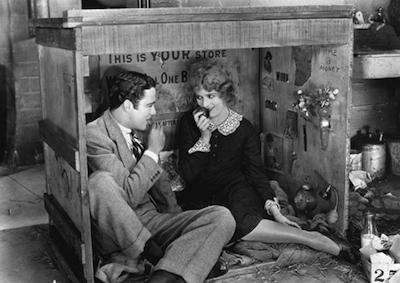Live musical accompaniment provided by Cliff Retallick.
You are here
My Best Girl / The Son's Return / A Manly Man

Restored by UCLA Film & Television Archive with funding provided by The Mary Pickford Foundation, The Packard Humanities Institute and The Film Foundation
My Best Girl (1927)
After nearly 15 years as the silver screen’s reigning “Queen of the Movies,” Mary Pickford lovingly concluded her silent movie career with one of her best films—the utterly charming romantic comedy, My Best Girl. Featuring future husband Charles “Buddy” Rogers as her leading man, Pickford shines as a department store Cinderella who falls in love with the owner’s son, once again exhibiting the wide-ranging talent that had made her a sensation the world over.
Based on a story by novelist Kathleen Norris, the screenplay (originally titled Paradise Alley) was written by Hope Loring, who had co-authored Paramount’s successful World War I epic Wings (1927)—which had featured Rogers. An attraction between the two actors sparked during Roger’s audition with Pickford and subsequently blossomed while the cameras rolled. As Pickford biographer Jeffrey Vance relates, “What makes My Best Girl special is that it captures the miracle of two people falling in love with each other as their characters do. It is challenging to capture genuine emotion on a cold piece of celluloid, but falling in love is beautifully immortalized in My Best Girl.” Fittingly, the movie depicts Pickford’s first romantic screen kiss in a feature film.
Director Sam Taylor honed his comedy chops directing and co-directing a string of classic Harold Lloyd films (including Safety Last!, 1923; and The Freshman, 1925), and his experienced hand is especially evident in the film’s overall polish and by the engaging way he textures the strange and quirky characters that populate the shop girl’s milieu. The sophisticated photography was contributed by longtime Pickford cinematographer Charles Rosher. Fresh from his Oscar-winning work on F.W. Murnau’s Sunrise (1927), Rosher created a special lens, the “Rosher Kino Portrait Lens,” for Pickford’s close-ups on My Best Girl to help the 35-year-old actress portray her 17-year-old character. While Taylor would go on to direct most of Pickford’s sound pictures, My Best Girl would prove to be Rosher’s last completed film with the star actress and producer.
This new print of My Best Girl is based on the Archive’s earlier restoration, which combined the best shots from two 35mm acetate fine grains and a 1940s-era 16mm print, and featured remade intertitles to improve the overall appearance of the film. This new print incorporates several recent refinements, including better quality copying of shots derived from the 16mm source and improved timing. —Steven K. Hill
Director: Sam Taylor. Production: Mary Pickford Corp. Distribution: United Artists Corp. Screenwriters: Allen McNeil, Tim Whelan. Based on the story My Best Girl by Kathleen Norris. Cinematographer: Charles Rosher. Cast: Mary Pickford, Sunshine Hart, Lucien Littlefield, Carmelita Geraghty, Hobart Bosworth. 35mm, b/w, silent, approx. 90 min.
Restored in cooperation with The Mary Pickford Company and the Library of Congress Packard Campus for Audio-Visual Conservation from two 35mm acetate fine grain master positives and a 16mm print. Laboratory services by Cinetech, The Stanford Theatre Film Laboratory, Title House Digital.
Restored by UCLA Film & Television Archive with funding provided by The Packard Humanities Institute, The Mary Pickford Foundation, and the Museum of Modern Art
The Son's Return (1909)
This recently re-discovered Biograph short features Mary Pickford in her second major screen role. In it, she plays Mary, the sweetheart of Will (Charles West), a country innkeeper’s son who heads to the big city and becomes a successful banker. After five years, he returns to his poverty-stricken parents, who do not recognize him and plot to rob their own son. Fortunately, Mary steps in to help the drama end happily. The Son’s Return was directed by D.W. Griffith and was shot on location in Leonia and Coytesville, New Jersey. —Sloan DeForest
Director: D.W. Griffith. Production: The Biograph Company. Distribution: The Biograph Company. Screenwriter: D.W. Griffith. Based on a story by Guy de Maupassant. Cinematographer: William Bitzer. Cast: Herbert Prior, Anita Hendrie, Mary Pickford, Harry Solter, Mack Sennett. DCP, b/w, silent, 11 min.
Restored from the 35mm nitrate Biograph camera negative. Laboratory services by Cinelicious. Special thanks to: Alan Boyd—the Library of Congress.
Restored by UCLA Film & Television Archive with funding provided by The American Film Institute/National Endowment for the Arts Film Preservation Grants Program and The Packard Humanities Institute
A Manly Man (1911)
Of the over 30 one-reelers Mary Pickford made in Cuba for Carl Laemmle’s Independent Motion Pictures Company, A Manly Man is one of few that survives today. Pickford plays Lola, a young Filipino woman who falls in love with Duncan (William E. Shay), a Caucasian man sent to her village on business. After Lola risks her life nursing his fever and saving him from a knife attack, Duncan marries her and resists the temptation to return to his American fiancée. Directed by Thomas Ince and co-starring Pickford’s first husband Owen Moore, A Manly Man was later reissued under the title His Gratitude (1914). —Sloan DeForest
Director: Thomas H. Ince. Production: Independent Moving Pictures Co. of America. Distribution: Motion Picture Distributors and Sales Company, Universal Film Manufacturing Co. Producer: Carl Laemmle. Cinematographer: Tony Gaudio. Cast: William E. Shay, Mary Pickford, Owen Moore, Isabel Rea, Charles Arling. 35mm, b/w and tinted, silent, approx. 12 min.
Restored from a 35mm nitrate print of the re-titled 1914 reissue version, His Gratitude. Laboratory services by The Stanford Theatre Film Laboratory, Film Technology Company, Inc.
To report problems, broken links, or comment on the website, please contact support
Copyright © 2025 UCLA Film & Television Archive. All Rights Reserved






 Mobile Navigation
Mobile Navigation
